Do you know that feeling when you enter a small laundry room and wish it looked better?
Maybe your socks keep disappearing, or your detergent is buried under towels. If you’re like me, you’ve asked, “Why does laundry feel like an extreme sport?” 😅
Here’s some good news! No matter if you have a tiny closet or a big laundry room, layout matters.
In this article, we’ll look at the best laundry room designs. You’ll learn how to make your space work better. It’s not just about cramming everything into a corner.
We want a space that truly fits your needs. So, let’s get started!
Understanding What Makes a Laundry Room Layout Efficient
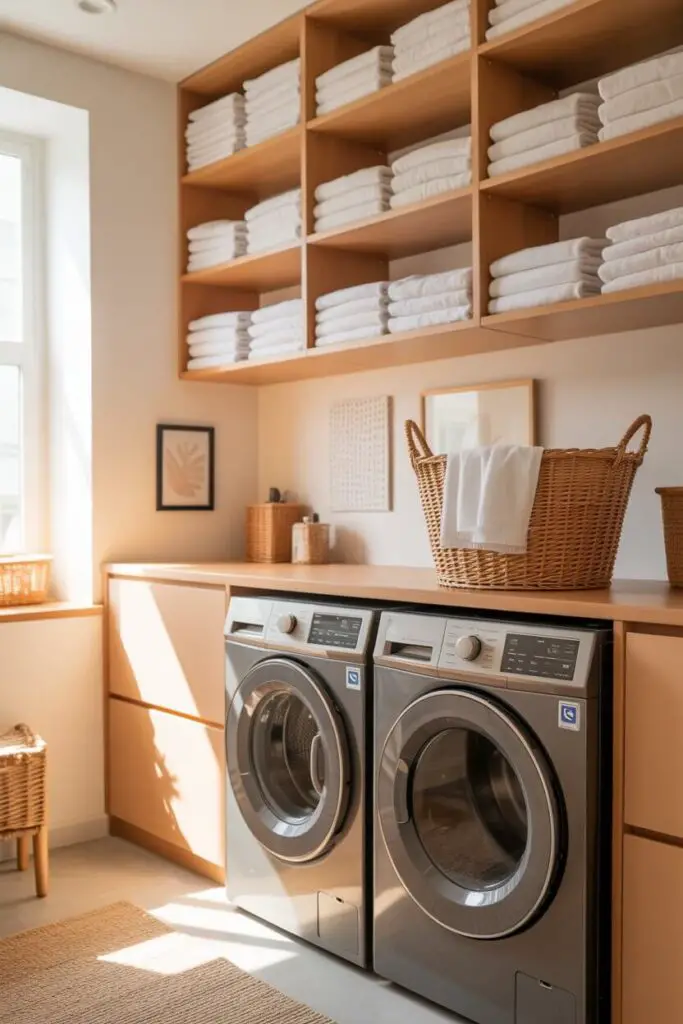
Before we dive into layouts, let’s get on the same page.
What do we mean by “efficient”? Well, it’s all about reducing the time and effort it takes to do laundry while also making the best use of your space.
The perfect layout will save you time, make sorting clothes easier, and even make folding more enjoyable (okay, maybe that’s a stretch).
So, what should you aim for in your laundry room?
- Good flow: A layout that minimizes back-and-forth.
- Storage options: Shelves, baskets, and hooks to keep things organized.
- Accessibility: Everything within arm’s reach, no awkward bending or stretching required.
- A little bit of charm: Because who says doing laundry has to be a chore, right?
The Work Triangle: The Gold Standard
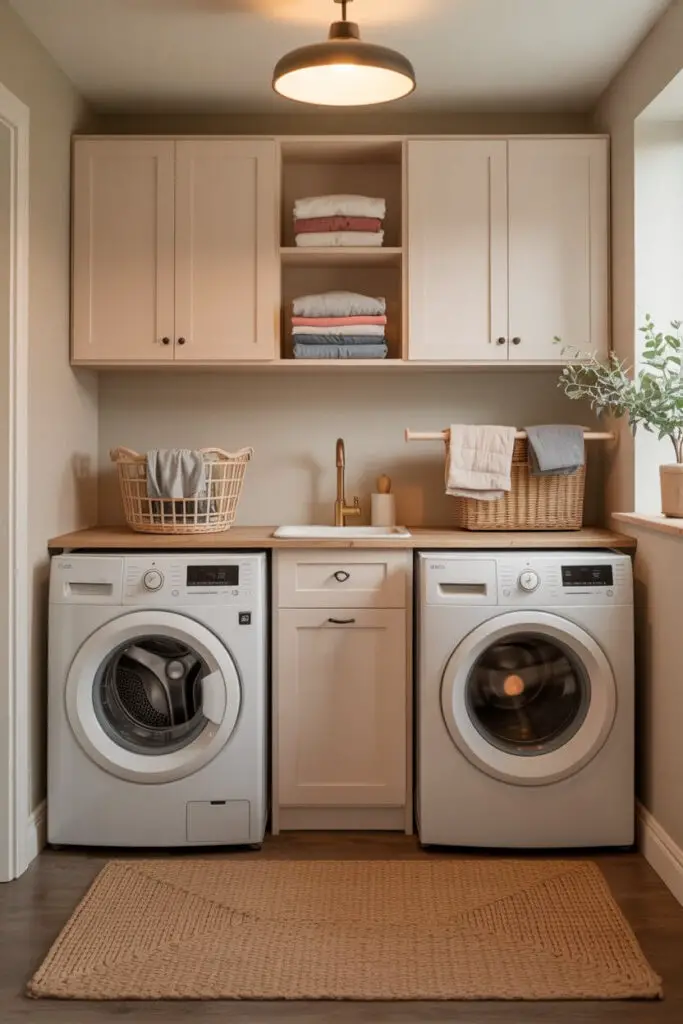
The first and most basic principle to think about when designing your laundry room layout is the work triangle.
No, it’s not some secret math term, though it might feel like one. It refers to the relationship between your washing machine, dryer, and folding or sorting area.
What’s so special about it?
It’s simple: a good work triangle ensures you aren’t running across the room multiple times or bumping into things while trying to transfer clothes from one station to another.
Here’s how to set it up:
- Washing Machine: Ideally placed near the entry to the room so you can easily load and unload.
- Dryer: Right next to the washing machine for easy transfer.
- Folding Area: A countertop or table between or near these two machines, giving you a nice space to fold without running around.
When this setup works, your laundry time just becomes a little bit less… annoying.
Small Laundry Room? No Problem!
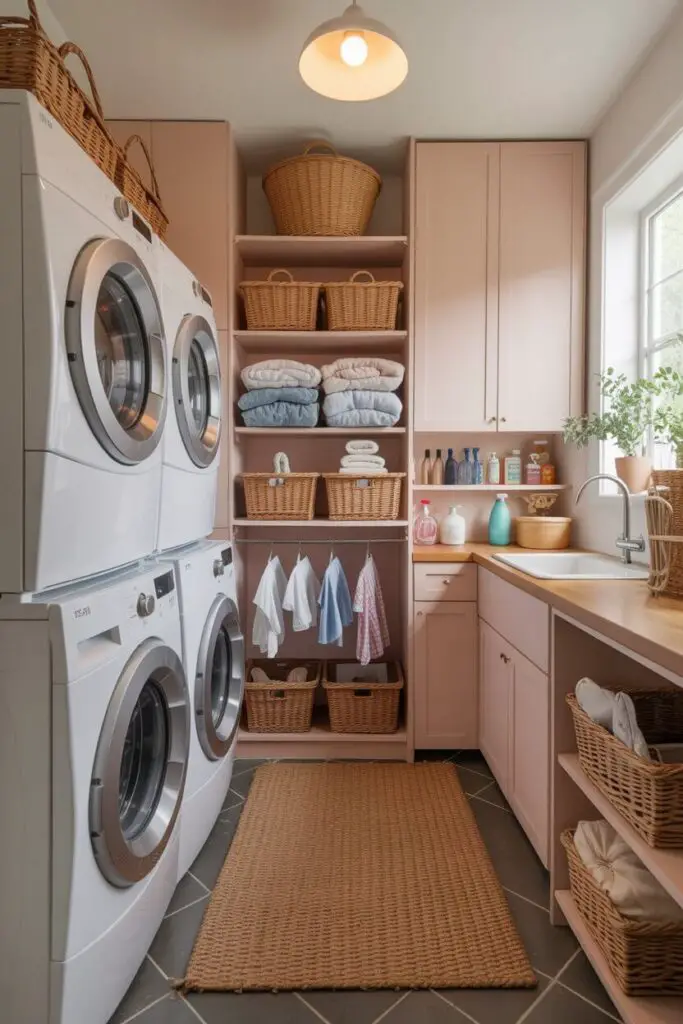
Not every laundry room has the luxury of size, and trust me, I get it. A tiny space can feel like a challenge, but with the right layout, you’ll make it work. Here are some tips:
- Stackable Units: If floor space is tight, stacking your washer and dryer vertically will free up some much-needed room. Plus, it creates a more streamlined look.
- Hidden Storage: Use cabinets, baskets, or even rolling carts to store detergents and cleaning supplies. Keep them tucked away to avoid clutter.
- Multipurpose Spaces: If your laundry room doubles as a mudroom or pantry, make sure each zone is clearly defined but still flows together. A laundry room doesn’t need to be solely for laundry!
Pro tip: Create vertical storage using wall-mounted shelves. Trust me, you’ll be amazed at how much extra space you get by thinking upwards. 😊
Spacious Laundry Room: How to Maximize It
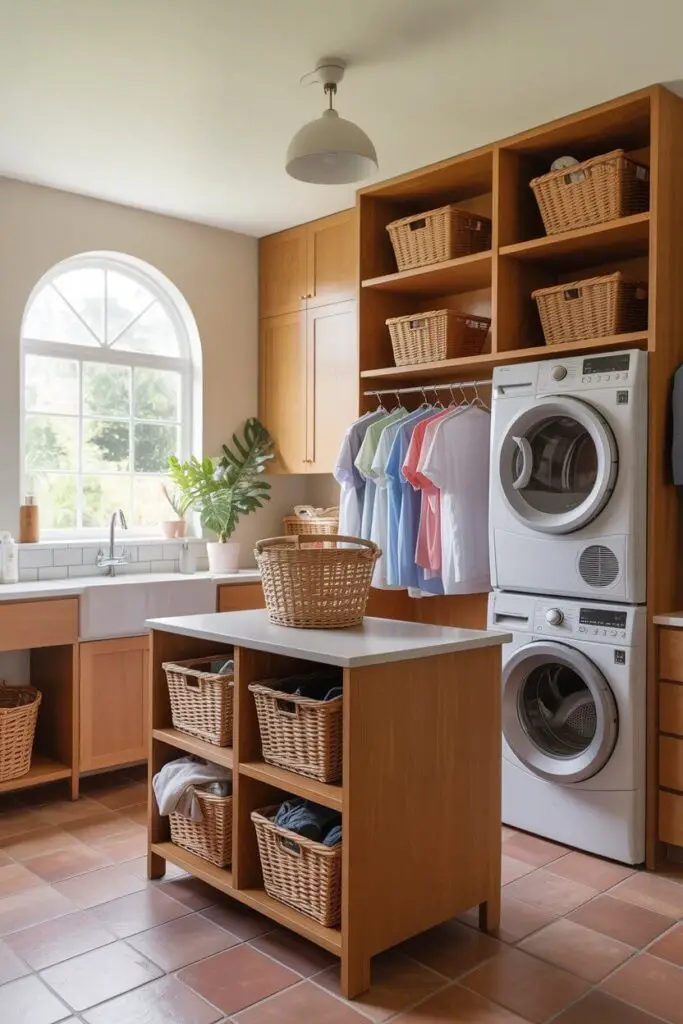
Now, if you’re one of the lucky ones with a larger laundry room, don’t just throw things around. You’ve got space, so let’s use it wisely.
Here are some ideas for maximizing a bigger space:
- Island or Countertop: A large counter (or even a dedicated folding island) is key to efficiency. It gives you a place to sort, fold, or even store baskets.
- Laundry Sink: If you’ve got the space and budget, a utility sink is a game-changer. It’s perfect for soaking clothes or washing off dirty shoes, and let’s be honest, it feels fancy.
- Separate Zones: Divide the room into zones. One side for washing and drying, the other for sorting, folding, or even ironing if that’s your thing.
The goal is to keep things organized. The more space you have, the more opportunities there are to create chaos. So, a good layout here is all about balance.
Open Shelving vs. Cabinets: What’s the Best Storage Option?
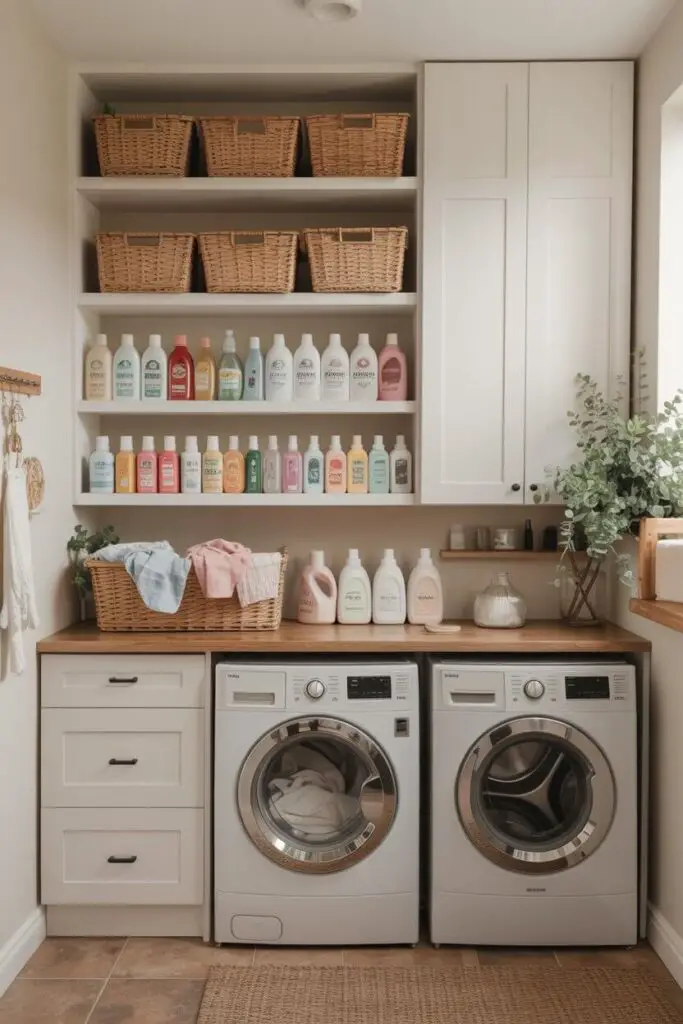
One of the most important decisions you’ll make when designing your laundry room is how to store your laundry products.
Should you go with open shelving or stick with cabinets?
Let’s weigh the pros and cons:
- Open Shelving:
- Pros: Quick access, easy to grab what you need, visually appealing.
- Cons: Can get messy quickly, requires more upkeep to keep things looking neat.
- Cabinets:
- Pros: Keeps everything hidden, more streamlined appearance, can handle bulkier items.
- Cons: Takes a bit more time to grab what you need, can feel “closed off” or less accessible.
My personal take: If you’re neat and tidy, open shelving can give your laundry room a modern, airy feel.
But if you’re prone to piles of detergent bottles and fabric softener in random places, cabinets might be your friend.
Do You Need a Folding Table?
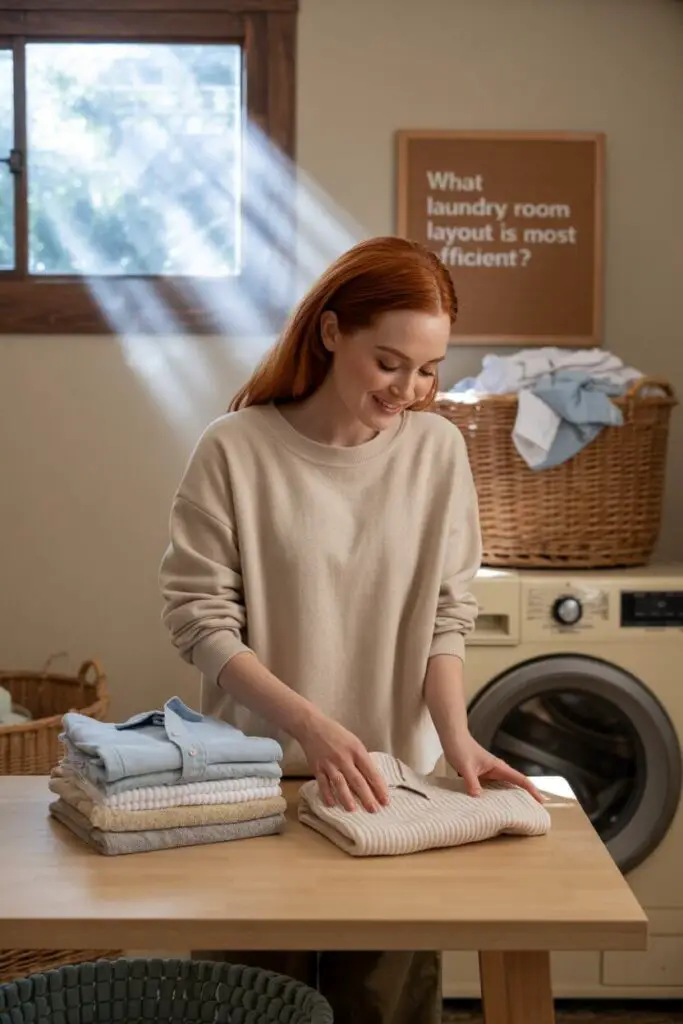
This one’s a bit subjective, but if you do a lot of laundry, a folding table might be a game-changer.
It doesn’t have to be a fancy piece of furniture, just something that allows you to fold clothes comfortably without losing your mind in the process.
Why you should consider one:
- Convenience: It’s nice to have a dedicated spot to fold clothes. You can even use it for sorting before or after washing.
- Efficiency: If you don’t have a folding area, you might end up dumping clothes all over the floor, adding unnecessary steps.
Lighting and Ventilation: The Unsung Heroes
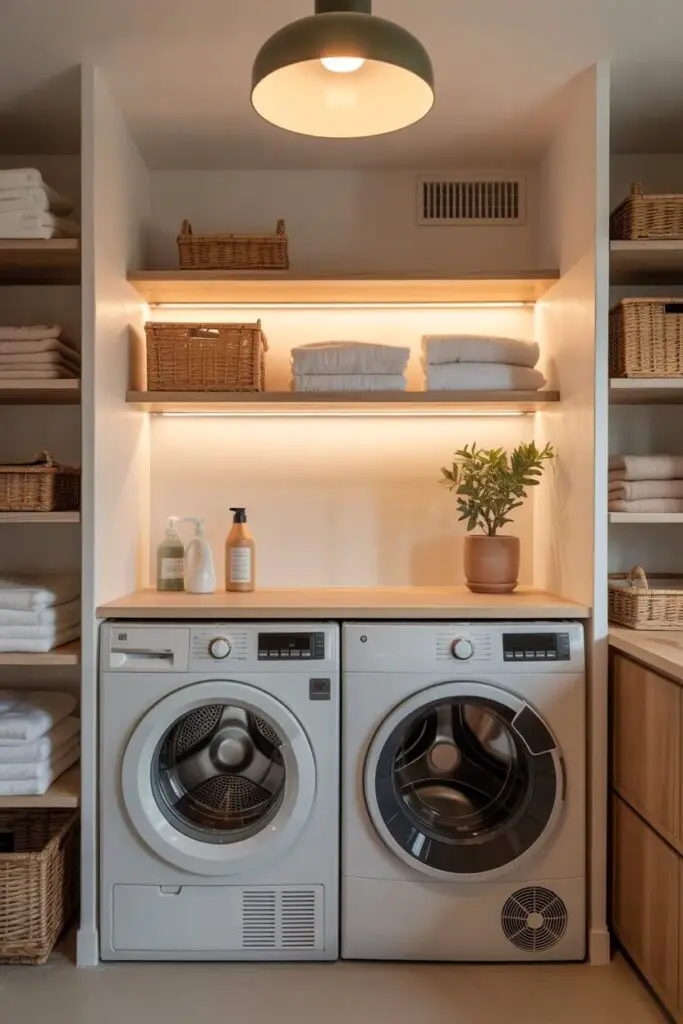
Okay, hear me out. We often focus on the machines and storage, but lighting and ventilation can make a huge difference in how efficiently you do laundry.
- Good Lighting: A well-lit room means you’re not squinting to find your favorite shirt or trying to read detergent labels. Aim for overhead lights and maybe even under-cabinet lighting for an extra boost.
- Proper Ventilation: Especially if your laundry room is cramped, proper airflow is critical to prevent that musty smell and mold growth. A well-placed vent or even a small fan will help keep things fresh. Don’t underestimate it!
Conclusion: Time to Make It Work for You
At the end of the day, the most efficient laundry room layout is the one that works best for YOU.
Whether you’re rocking a tiny closet or a spacious room, the key is maximizing your space and creating a flow that makes doing laundry easier, not harder.
Have fun with it! Add some personal touches to make the space yours—because, let’s face it, if you have to do laundry, you might as well make it a space you can tolerate, right? 😆
Now, I want to hear from you. What’s your current laundry room situation? Anything you’d love to add or change? Let me know!